人教版七年级上册英语starter教案GoforitUnit1
- 格式:doc
- 大小:66.04 KB
- 文档页数:11
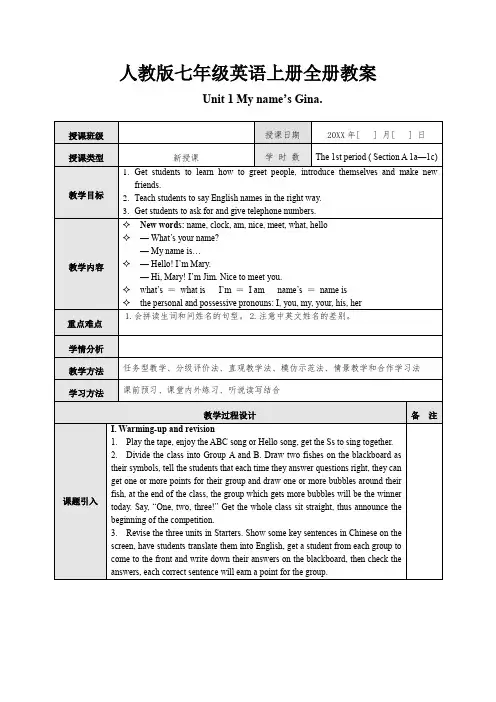
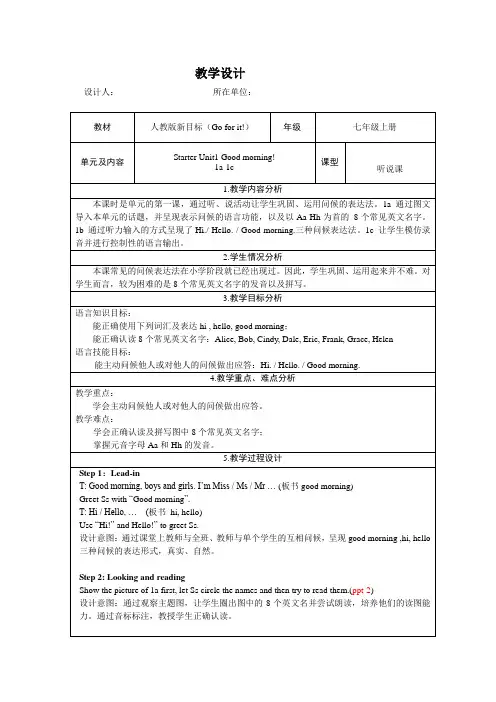
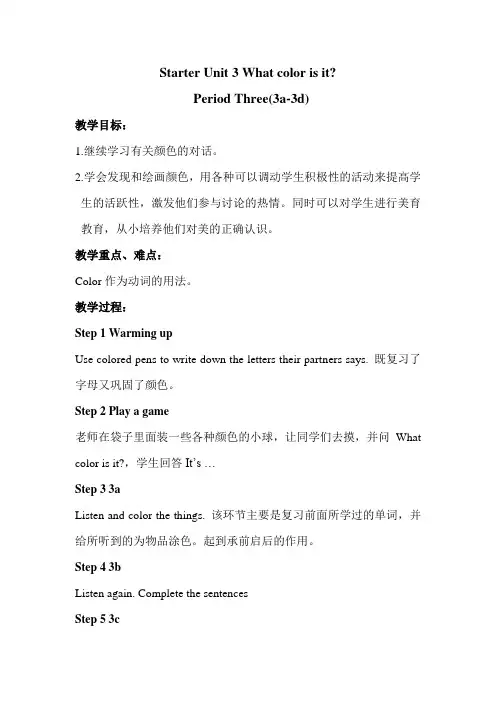
Starter Unit 3 What color is it?Period Three(3a-3d)教学目标:1.继续学习有关颜色的对话。
2.学会发现和绘画颜色,用各种可以调动学生积极性的活动来提高学生的活跃性,激发他们参与讨论的热情。
同时可以对学生进行美育教育,从小培养他们对美的正确认识。
教学重点、难点:Color作为动词的用法。
教学过程:Step 1 Warming upUse colored pens to write down the letters their partners says. 既复习了字母又巩固了颜色。
Step 2 Play a game老师在袋子里面装一些各种颜色的小球,让同学们去摸,并问What color is it?,学生回答It’s …Step 3 3aListen and color the things. 该环节主要是复习前面所学过的单词,并给所听到的为物品涂色。
起到承前启后的作用。
Step 4 3bListen again. Complete the sentencesStep 5 3cListen and complete the chart.该环节即要写出对话中的物品,又要写出对话中所提到物品的颜色。
再次从音、形上巩固颜色。
Step 6 3dMake conversations using the things in 3a-3c.通过同桌合作和组间比赛活动,提高学生的合作能力和竞争能力,促使学生学会体验实践、参与合作与交流的学习方式。
Step 7 Homework1. Copy the conversations in 3d and write down the Chinese meaning.2. Colors can make colors.板书设计:课后反思:。
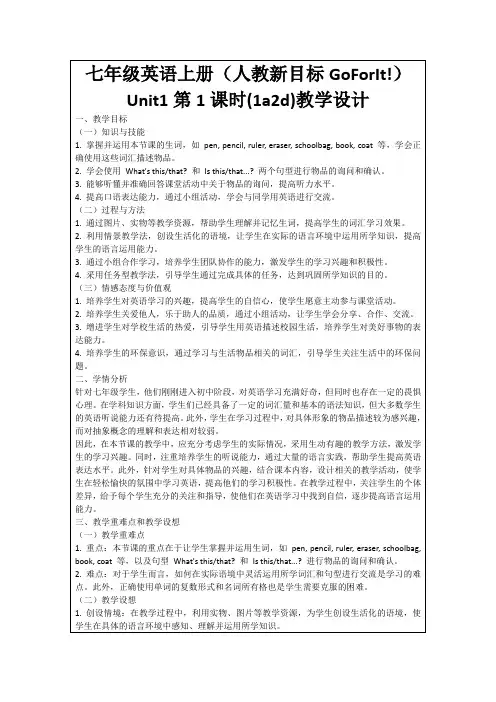
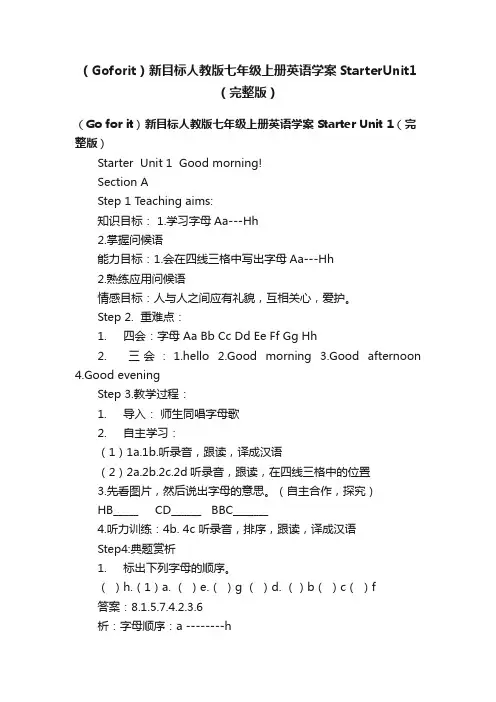
(Goforit)新目标人教版七年级上册英语学案StarterUnit1(完整版)(Go for it)新目标人教版七年级上册英语学案 Starter Unit 1(完整版)Starter Unit 1 Good morning!Section AStep 1 Teaching aims:知识目标: 1.学习字母Aa---Hh2.掌握问候语能力目标:1.会在四线三格中写出字母Aa---Hh2.熟练应用问候语情感目标:人与人之间应有礼貌,互相关心,爱护。
Step 2. 重难点:1. 四会:字母 Aa Bb Cc Dd Ee Ff Gg Hh2. 三会:1.hello 2.Good morning3.Good afternoon4.Good eveningStep 3.教学过程:1. 导入:师生同唱字母歌2. 自主学习:(1)1a.1b.听录音,跟读,译成汉语(2)2a.2b.2c.2d听录音,跟读,在四线三格中的位置3.先看图片,然后说出字母的意思。
(自主合作,探究)HB_____ CD______ BBC_______4.听力训练:4b. 4c 听录音,排序,跟读,译成汉语Step4:典题赏析1. 标出下列字母的顺序。
()h.(1)a. ()e.()g ()d. ()b()c()f答案:8.1.5.7.4.2.3.6析:字母顺序:a --------h2.—Good morning!----____________A. Good morningB.Good afternoonC.Good evening答案:A 析:别人问早上好时回答也用早上好。
Step5:中考链接1. 写出Aa---Hh 中的元音字母_________,___________2. ---Hello!---_____A. Good morningB.HelloC.AfternoonStep6.能力提升一.单选()1.Aa ____Cc Dd Ee----------A. FfB.GgC.Bb( ) 2.Aa Bb Cc D___ Ee Ff Gg HhA.bB.dC.p二.按顺序在四线三格中写出前8个英文字母—————————————————————————————三.写出大写形式:a _____b ____c ____d ___e ___f ___g ___h ____Starter Unit 1 Good morning!Section BStep1. Teaching aims知识目标:1.字母 Aa-----Hh2.掌握问候语能力目标:1.会在四线三格中写出字母Aa---Hh2.熟练应用问候语情感目标:人与人之间应有礼貌,互相关心,爱护。
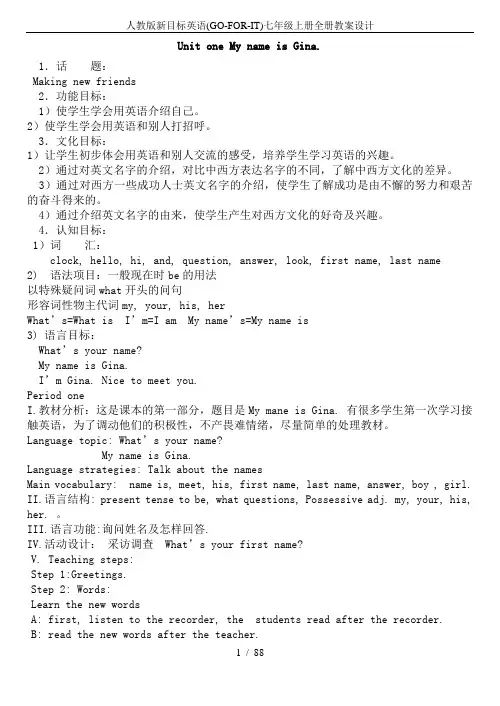
Unit one My name is Gina.1.话题:Making new friends2.功能目标:1)使学生学会用英语介绍自己。
2)使学生学会用英语和别人打招呼。
3.文化目标:1)让学生初步体会用英语和别人交流的感受,培养学生学习英语的兴趣。
2)通过对英文名字的介绍,对比中西方表达名字的不同,了解中西方文化的差异。
3)通过对西方一些成功人士英文名字的介绍,使学生了解成功是由不懈的努力和艰苦的奋斗得来的。
4)通过介绍英文名字的由来,使学生产生对西方文化的好奇及兴趣。
4.认知目标:1)词汇:clock, hello, hi, and, question, answer, look, first name, last name2) 语法项目:一般现在时be的用法以特殊疑问词what开头的问句形容词性物主代词my, your, his, herWhat’s=What is I’m=I am My name’s=My name is3) 语言目标:What’s your name?My name is Gina.I’m Gina. Nice to meet you.Period oneI.教材分析:这是课本的第一部分,题目是My mane is Gina. 有很多学生第一次学习接触英语,为了调动他们的积极性,不产畏难情绪,尽量简单的处理教材。
Language topic: What’s your name?My name is Gina.Language strategies: Talk about the namesMain vocabulary: name is, meet, his, first name, last name, answer, boy , girl. II.语言结构: present tense to be, what questions, Possessive adj. my, your, his, her. 。

人教版七年级上册英语s t a r t e r教案G o_f o r_i t__U n i t1Go for it! Book IUnit 1 Good morning!一.教材分析Go for it!学生用书每个单元包括Section A, Section B 和 Self Check三个部分。
它将话题,功能和交际巧妙地融合在一起,用一种循序渐进的生活化的学习程序引导学生把所学的语言知识和实际运用结合起来。
Section A 为基本的语言内容,并为目标句型提供分步示例和指导性练习;Section B是知识的扩展和综合的语言运用,使学生能够对已经学过的目标句型运用自如;Self Check 供学生用来自我检测本单元所学的语言知识,使学生对现阶段的英语水平,即对本单元的语言目标有较为明确的认识。
它的编排虽然仍以单元为单位,但是以TBL语言教学模式的板块设计,为课堂教学的灵活组织留下了更大的空间。
Starter Unit 1是Go for it!预备篇三个单元的第一单元。
预备篇是为了使那些没有英语基础的学生更好地使用本套教材而编写的。
它的主要内容为26个字母和最基本的英语日常用语。
本单元的教学内容为:1.学习Aa --- Hh八个字母。
2.学习八个人名。
Alice, Bob, Cindy, Dale, Eric, Frank, Grace, Helen3.学习打招呼的用语:Hello!/ Good morning!/ Good afternoon!/ Good evening!4.学会问候熟识的朋友和应答:-- How are you?-- I’m fine, thanks. How are you? -- I’m OK.二.教学设计思路Go for it!是以«英语课程标准»为依据,以培养学生的英语语言综合运用能力为目标,每个单元的教学内容都围绕一个话题,让学生在完成各项任务的过程中学会语言,真正体现:“Learn by doing. Learn by using.”这一教学原则。
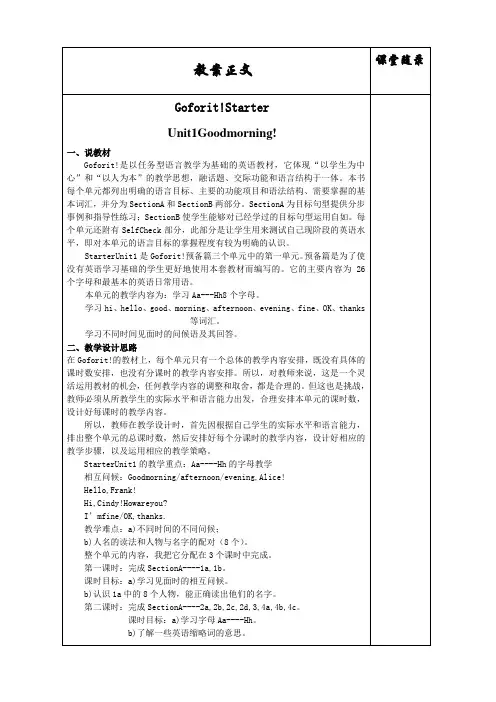
﹡.﹡.﹡,studentschantalongwiththetune.?StepⅣGamesGame1-巧排方阵?Answers:Game2招兵买马T:,studentswhogetA,E,I,O,五个元音字母AEIOU是司令,其它字母是小兵(按字母发音归类)Aa司令的小兵是Hh,Jj,Kk.Ee司令的小兵是Bb,Cc,Dd,Gg,Pp,Tt,Vv.Ii司令的小兵是Yy.Oo是一个光棍司令.Uu司令的小兵是Qq,Ww.〔e〕是一个假司令,它的小兵是Ff,Ll,Mm,Nn,Ss,Xx,ZzRr是一个流浪兵。
StepⅤListenandrepeat.SectionB2:﹡,readandreciteit.(3)Copythelettersin2andrememberthem.同颜色标出以引出下一部分的内容。
作为拓展也可让学生运用已学的词汇,自编chant。
具体操作:在图中填入字母,使每一横行、竖行和对角线中的五个方格内都含有A,E,I,O,U5个英语元音字母该游戏的目的是练习字母根据发音的归类。
如果该班人数较多,为了达到人人参与的目的,可以分发大小写字母,且要求大、小写字母结对去找司令。
Period5 (SelfCheck1,Justforfun)Teachingaims (教学目标)复习巩固26个大小写字母,培养观察、反应能力。
会唱英语字母歌。
熟练掌握英语字母表。
理解字母表在查字典中的作用,学会如何查字典,激励学生探索。
继续巩固颜色的相关单词Languagepoints(语言点)要求认识alphabet(字母表)Difficulties (难点):英语字母在字母表中的顺序。
查字典的步骤。
Teachingsteps(教学步骤)教学设计说明TellmeandIforget,teachmeandIremember,involvemeandIlearn.(本杰明·弗兰克林)第三单元微型试卷听力部分I听录音,写出紧跟你所听字母后面字母的大小写。
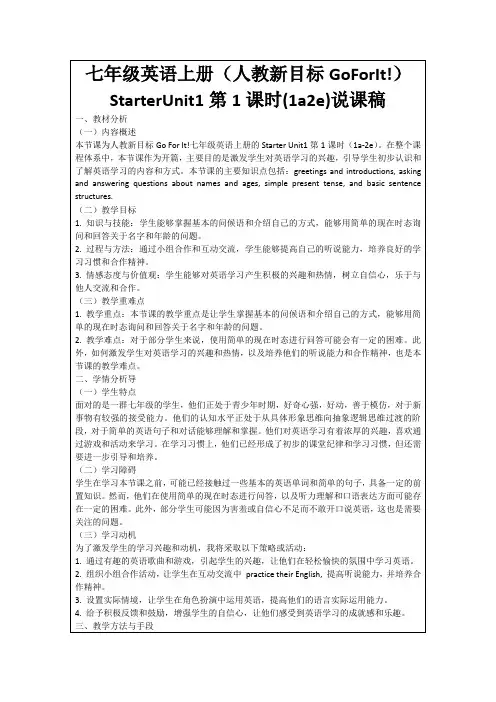
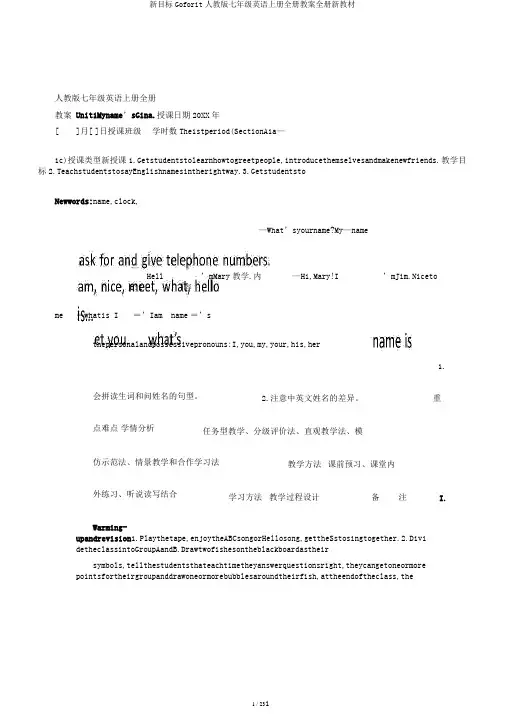
新目标Goforit人教版七年级英语上册全册教案全册新教材人教版七年级英语上册全册教案 Unit1Myname’sGina.授课日期20XX年[ ]月[ ]日授课班级学时数The1stperiod(SectionA1a—1c)授课类型新授课1.Getstudentstolearnhowtogreetpeople,introducethemselvesandmakenewfriends.教学目标2.TeachstudentstosayEnglishnamesintherightway.3.GetstudentstoNewwords:name,clock,—What’syourname?My—name—Hell o!I’mMary教学.内容—Hi,Mary!I’mJim.Nicetome =whatis I =’Iam name =’sthepersonalandpossessivepronouns:I,you,my,your,his,her1.会拼读生词和问姓名的句型。
2.注意中英文姓名的差异。
重点难点学情分析任务型教学、分级评价法、直观教学法、模仿示范法、情景教学和合作学习法教学方法课前预习、课堂内外练习、听说读写结合学习方法教学过程设计备注I.Warming-upandrevision1.Playthetape,enjoytheABCsongorHellosong,gettheSstosingtogether.2.DividetheclassintoGroupAandB.Drawtwofishesontheblackboardastheirsymbols,tellthestudentsthateachtimetheyanswerquestionsright,theycangetoneormore pointsfortheirgroupanddrawoneormorebubblesaroundtheirfish,attheendoftheclass,thegroupwhichgetsmorebubbleswillbethewinner课题引入today.Say,“One,two,three!〞Gettheasswholesitstraight,clthu sannouncethe beginningofthecompetition.3.RevisethethreeunitsinStarters.Showsomekeysentencesin Chineseonthe screen,havestudentstranslatetheminto English,getastudentfromeachgroupto cometothefront andwrite downtheiranswersontheblackboard,thencheckthe answers,eachcorrect sentencewillearnapointforthegroup.II.Presentation1.Teachersays:,“My Hello!nameisLily.What’syour name?〞Getthe studentstoanswer,“Mynameis〞Theteachersays,“It’sagood/nicename.Ilikeyourname.〞2.screenshowalovelymousesaying“Myname’sGina.〞Underline“Myname’s〞,tellthestudentsitmeans学步骤3.Showthequestion“What’yours“Mynameis/教Iam/Iname?〞Underline “What’s〞,tellthestudents及thatitmeans“What主is要内〞容.III.Listeningdrills(1)1.DoSectionA,1b,listenandnumbertheconversations(1-3).2.Showthepictureonpage1onthescreenwithnowordsonit.Getstudentto listentothetapeandtryto repeatthesentencesintheconversations,each correctsentencewillearnapointforthegroup.IV.Pair-work.1.Getthestudentslistentotheconversationsagainandrepeatafterthetape,thenworkingroups,practicetheconversationswiththepartners.2.Havesomestudentscometothe frontandshowtheirownconversation,then makeacommentonit(praisethestudentsfirst)andgive2to4pointstotheirgroup. 3.DoSectionA,1a.First,havethestudentsworkingroups,writedownasmany课堂练习wordsaspossibleontheirstudents’booksinonly2minutes;thengeta studentfromeachgrouptowritedowntheirwordsontheblackboardatthe sametime,theonewhowritesmorecangetmorepoints.V.Listeningdrills(2)1.DoSectionA,2a.Listentofourconversationsandnumberthepictures(1-4). 2.DoSectionA,2b.Listenagain,circlethenamesaccordingtothetape.Listenforthelasttime,thenfillintheblanks.小结与作业课堂小结 1.Listenandreadafterthetapeforthirtyminutes. 2.RecitethefirstconversationofSectionA,2c.Chinesemeaningofthenew本课作业3.Writedownthewordsandkeysentences,then translatethemintoEnglish.本课教学后记〔课堂设计理念,实际教学效果及改良设想〕Unit1Myname’sGina.授课日期20XX年[]月[]日授课班级The2ndperiod(SectionA1c--4)学时数授课类型对话课1.Getthestudentstolearnhowtogreetpeople.2.Getthestudentsto learnto getotherpeople’basicinformationlikenamesfromthe教学目标--What’syour/his/hername?教学内容--My/His/Hernameis、了1解英语与汉语中姓与名的位置不同,准确掌握英语的姓与名的表达;2、听懂并能说出号码,培养学生的英语意识。
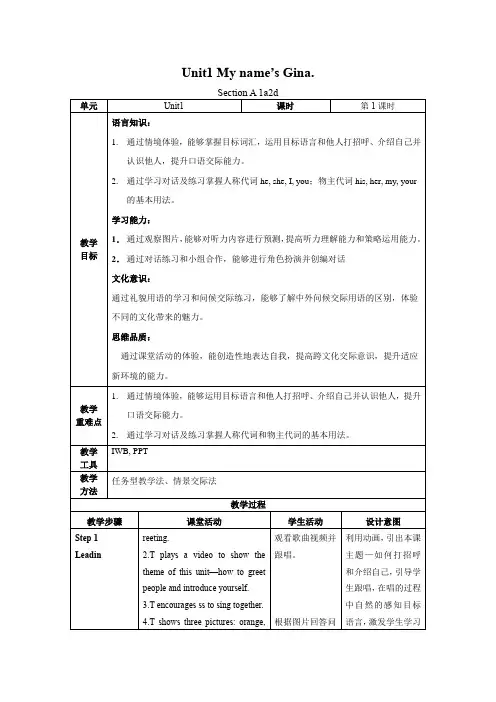
Starter Unit 1 Good morning!The First Period (1a–1c)Teaching aims (教学目标)1. 能识别书中的八个人物。
2. 学会八个人名的读音。
3. 学会早上见面打招呼的用语。
Language points (语言点)1. 词汇:1) 名词n.:morning, Alice, Bob, Cindy, Dale, Eric, Frank, Grace, Helen2)形容词adj. :good3) 感叹词interj. :hi, hello2. 句型:Hello! Good morning!Difficulties (教学难点):1. 八个英语名字的正确发音;2. 字母A, C, G, H的正确发音Teaching steps (教学步骤)1. Warm-up (课堂热身)(1) Put a name card with your English name above and Chinese name below on your desk. Then point to the name card and introduce yourself.T: This is my name card. I have a Chinese name ... And I have an English name ... You can call me...(2) Greet the whole class and help them to say,Hello, ... ! Good morning, ...! (2. Presentation (呈现新知识)Show the picture on page S1 on the PPT and help Ss to learn to pronounce the names. Say,Here are some students. Let’s look learn their names.3. Work on 1a (完成1a)(1) Show the picture on page S1 on the PPT. (此步骤不出现问候语)(2) Point to the persons and have Ss say their names.(3) Say one of the names and have Ss repeat it, and then write it below Boys’ names or Girls’ names in the book.(4) Check Ss’ answers.E.g. T: Li Lei.S: Yes.(示意学生起立回答问题)T: Is Frank a boy’s name or a girl’s name?S: A boy’s name.T: Right. Sit down, please.S: Thank you.4. Presentation (呈现新知识)Show a picture with Bob and Helen and have Ss guess what Bob would say to Helen. The answer may be: Hello, Helen! or Good morning, Helen!5. Work on 1b (完成1b)(1) Play the recording for the first time. Ss only listen.(2) Play the recording for the second time. Students listen and repeat.(3) Play the recording for the third time. Students look, listen and repeat.T: Now please open your books to page S1. You can look at the conversations in your book. Let’s listen and repeat.6. Work on 1c (完成1c)(1)Have Ss practice reading the conversations in the picture in pairs. Move around the classroom when Ss are practicing. Give them help if needed.(2)Greet Ss using their English names. The other Ss listen, watch and learn.(3)Students practice greeting each other. They can use their Chinese names if they wish. Encourage them to use their English names if they can.(4)T: Now I’ll ask some pairs to say your conversation to the class.7. Homework (课后作业)(1)听读模仿1a,并且背诵。
本单元重点话题是自我介绍,也包括询问他人姓名和介绍他人及询问他人的电话号码。
通过自我介绍来呈现be 动词的一般现在时的两种形式am 和i s, 通过询问他人名字和电话号码来呈现本单元的重点句式What is…? 和重点语法项目---形容词性的物主代词:my, your, her , 和his。
三、教学过程建议本单元从其内容而言,也类似一个过渡单元。
自我介绍可能已不再有新鲜感,可以通过给学生取英语名字来激发兴趣,把课本上的名字都反映出来,以减小词汇中姓名教学的难度,同时也允许学生给自己取他们自己喜欢的英文名字。
尽量多采用小组和班级活动的方式表现词汇和句式。
如姓名、数字游戏、制作名片、名人档案等,让基础较好的学生发挥示范作用,让所有的学生都参与。
在教授物主代词your ,his 和her 时,可以通过距离和性别来反映,让学生在观察中领悟。
Period one课型:Watching, Listening and Writing方法:Interactive approach主要内容:Key vocabulary:my, name, clock, nice, meetKey structures:What’s your name?Nice to meet to you!目标:To learn to greet others and make simple introduction involving his or h er name.To review some of the old words such as book, fish, fall, clock, etc.教学步骤:Step 1 Warming-up操作:·教师以问候形式开始第一节课,教师可以说:Nice to meet you, everybody!如果学生不能正确反应,帮他们作答。
·教师接着作一个自我介绍,说:My name is…, I’m…years old. 引导出目标语言并写在黑板上。
Starter Unit 1 Good morning!教材解读Go for it!是以任务型语言教学为基础的英语教材,它体现“以学生为中心”和“以人为本”的教学思想,融话题、交际功能和语言结构于一体。
本书每个单元都列出明确的语言目标、主要的功能项目和语法结构、需要掌握的基本词汇,并分为Section A和Section B 两部分。
Section A为目标句型提供分步事例和指导性练习;Section B使学生能够对已经学过的目标句型运用自如。
每个单元还附有Self Check部分,此部分是让学生用来测试自己现阶段的英语水平,即对本单元的语言目标的掌握程度有较为明确的认识。
Starter Unit 1是Go for it!预备篇三个单元中的第一单元。
预备篇是为了使没有英语学习基础的学生更好地使用本套教材而编写的。
它的主要内容为26个字母和最基本的英语日常用语。
本单元的教学内容为:学习Aa-Hh 8个字母。
学习hi、hello、good、morning、afternoon、evening、fine、OK、thanks等词汇。
学习不同时间见面时的问候语及其回答。
单元目标一、知识与技能1. 掌握字母Aa-Hh,能认读其印刷体和手写体字母的大小写等四种形式。
2. 相互问候:Good morning/afternoon/evening, Alice!Hello, Frank!Hi, Cindy! How are you?I’m fine./OK, thanks.二、过程与方法灵活运用教材,从所教学生的实际水平和语言能力出发,调整和取舍教学内容,合理安排本单元的课时数,设计好每课时的教学内容。
三、情感态度与价值观万事开头难,首先利用这个单元培养学生们对英语的兴趣,因为兴趣是最好的老师。
教法导航1. 以任务型教学作为课堂教学理念、利用整体语言教学法、情景教学法、交际教学法等。
2. 在教学中创设切实可行的任务型教学活动、突出交际性。
新目标英语(Go for it)七年级上册教案Starter Unit 1 Good morning!一.教材分析:本单元要求学生掌握英文字母A—H,能认读其印刷体和手写体字母的大小写等四种形式。
书写(大写和小写,笔顺,笔画)基本合乎要求。
能看,听,说本单元所列的日常交际用语,重点学会打招呼,并做到语音语调准确。
注意一些字母及日常交际用语的发音,提醒学生不要将C/si:/发成/sei:/等。
二.学情分析:教师要尽量用英语组织教学。
充分利用课堂的40分钟,不讲或少讲汉语,尽量给学生创造英语情景。
教师能够用手势,表情,动作等示意,协助学生听懂课堂用语和日常交际用语,第一次介绍某个用语时,说英语,加译文及手势,以后可酌情省去译文,最后只说英语,逐步让学生听懂。
万事开头难,首先利用这个单元培养学生们对英语的兴趣,因为兴趣是最好的老师。
体会打招呼用语的奥妙所在,做到灵活使用。
三.教学过程:Period 1Step 1:IntroductionBegin by greeting the class with a smile and good morning!Now,introduce the words “teacher” and “class”.by using gestures.Repeatthis several times and have the class repeat after you.Students Can answer as a whole group.As rows and as individuals.Repeat “I am your teacher and you are the class” several times.Now,introduce the class to the instructions:Class,please sit downand class,please stand up by using actions and gestures.They can practice this several times.Step 2:Lead—inYou may want t0 leave the class again to introduce the usual Good morning routine.Say Good morning class.Help students respond with Good morning.Point to yourself and say I’m Miss/,Mr.…Have them repeat.Explain the terms Miss and Mr.in Chinese.Repeat this a few times with rows and individuals or try a “back-chain” drill:Miss,Mr.… (Ss repeat)Morning,Miss/M r.… (Ss repeat)Good morning,Miss,Mr.… (Ss repeat)Step 3:PracticeSay:Stand up,please! (Ss stand up)Leave the classroom,return and say Good morning,class! Help the students respond with Good morning,Miss/,Mr.…Say Sit down,please.Now let’s start the lesson.Step 4:Presentation and activityNow point to yourself and say My name is Miss/Mr. … I am your teacher.Find a student you know and say your name is…(Beth).Then ask What is your name? Help them respond with My name is… . When the student answers, respond with Hello…Nice to meet you! Repeat this activity several times,first with students you know and then with others.Help them to respond with Nice to meet you,too.Explain the Word “too’’ in Chinese.Step 5:PracticeGet the students to practice the f0llowing dialogue in pairs.S1:Good morning.S2:Good morning.I’m (Ben).What’s your name?Sl:My name is (Dale).Nice to meet you!S2:Nice to meet you.too.Call out several pairs of students to give their performance.Praise their efforts as much as possible.Help the slower students withpatience.Step 6:PresentationDo activity 1a:Look at the picture.Find the small letters for these big letters.First present letters a-h,and get the students to repeat these letters.Call the students to attention the letter C/si:/not/sei:/.H /eʧ/ not /eʧ/Step 7:Listening and writingGet the students to listen to the tape and finish the task list on the book.Make sure all the students know what they should do.Have the students watch the teacher writing the letters on the blackboard, then ask them to follow the teacher and write down these letters on their exercise—books.Let the students know the diffences between the big letters and the small letters.Step 8:Games timeLet the students do some letters games to enjoy your lesson,the following is the instruction.抢读字母游戏:教师将全班分成若干小组,然后逐个出示字母卡片,学生们举手抢答。
Go for it! Book IUnit 1 Good morning!一.教材分析Go for it!学生用书每个单元包括Section A, Section B 和Self Check三个部分。
它将话题,功能和交际巧妙地融合在一起,用一种循序渐进的生活化的学习程序引导学生把所学的语言知识和实际运用结合起来。
Section A 为基本的语言内容,并为目标句型提供分步示例和指导性练习;Section B是知识的扩展和综合的语言运用,使学生能够对已经学过的目标句型运用自如;Self Check 供学生用来自我检测本单元所学的语言知识,使学生对现阶段的英语水平,即对本单元的语言目标有较为明确的认识。
它的编排虽然仍以单元为单位,但是以TBL语言教学模式的板块设计,为课堂教学的灵活组织留下了更大的空间。
Starter Unit 1是Go for it!预备篇三个单元的第一单元。
预备篇是为了使那些没有英语基础的学生更好地使用本套教材而编写的。
它的主要内容为26个字母和最基本的英语日常用语。
本单元的教学内容为:1.学习Aa --- Hh八个字母。
2.学习八个人名。
Alice, Bob, Cindy, Dale, Eric, Frank, Grace, Helen3.学习打招呼的用语:Hello!/ Good morning!/ Good afternoon!/ Good evening!4.学会问候熟识的朋友和应答:-- How are you?-- I’m fine, thanks. How are you? -- I’m OK.二.教学设计思路Go for it!是以«英语课程标准»为依据,以培养学生的英语语言综合运用能力为目标,每个单元的教学内容都围绕一个话题,让学生在完成各项任务的过程中学会语言,真正体现:“Learn by doing. Learn by using.”这一教学原则。
但是在Go for it!的教材上,每个单元只有一个总体的教学内容安排,既没有具体的课时数安排,也没有分课时的教学内容安排。
所以,对教师来说,有更大的自由度来灵活运用教材,为自己的学生来量身定做学习方案。
在Go for it!教材的使用过程中教师依据自己学生的实际水平和语言能力,对教学内容所作的任何调整和取舍,都应该是合理的。
这也更有利于个性化教学的开展。
Starter Unit 1是该教材的第一单元,又是为初学者准备的入门单元,总体内容不多,也不是很难,关键是做好一个衔接工作,根据学生的认知特点和心理特点,通过多样化的、趣味性的学习活动,让没基础的同学克服心里的畏难情绪,感觉到英语不难又很有趣;让有基础的同学更进一步培养起对英语学习的兴趣和自信。
Starter Unit 1教学重点:Aa --- Hh的字母教学。
Hello! Good morning. Good afternoon. Good evening.-- How are you? -- I’m fine, thanks. How are you? -- I’m OK.教学难点:课本中英语人名的学习和大、小写字母的学习及书写。
整个单元的内容,可分配在四个课时中完成。
第一课时:完成1a,1b,1c第二课时;完成2a,2b,2c,2d,2e第三课时:完成3a,3b, 3c,3d第四课时:完成4a,4b,4c,4d三.教学目标A.语言知识目标1.词汇: Letters Aa --- Hh八个人名Alice, Bob, Cindy, Dale, Eric, Frank, Grace, Helen 2.句型:Good morning. Good afternoon. Good evening.-- How are you? -- I’m fine, thanks. How are you? -- I’m OK. B. 语言技能目标通过游戏等多种形式的学习活动,培养学生对初学知识的听、说、读、写能力和灵活运用初学的日常交际用语的能力。
C. 情感目标1. 激发学生学习英语的兴趣,发挥学生学习英语的积极性和主动性。
2.通过小组活动,培养学生的合作意识和团队精神。
3.在活动中培养学生的思维能力和创新能力。
四.教学策略1.以趣激学:采用做游戏和猜谜等学生所喜闻乐见的学习形式激发学生的参与热情。
2.以放促学:开放地处理教材,插入大量有趣的图片、增加多种趣味活动,充分利用学生自主搜集的图文信息,拓宽学生的视野,实现知识的整合。
3.以任务导学:以话题为纲,以任务为主线,以合作交际为方式,培养学生用英语交流信息,获取信息和处理信息的能力。
五.学习策略1.交际策略:学会与他人合作交流,并能把语言材料用到真实的生活中去。
2.资源策略:学会利用多种学习资源来获取更多的学习信息。
3.认知策略:主动思考(观察力、注意力、想象力、逻辑推理能力等),大胆实践,及时反馈。
4.调控策略:通过课堂反馈和self-check,明确自己的学习状况,不断调整自己的学习策略。
六.教学过程Period One(1a,1b,1c)Teaching aims:1.识别和掌握八个人名。
2.学会早上见面打招呼的用语。
Language points.1.词汇:Alice, Bob, Cindy, Dale, Eric, Frank, Grace, Helen2.句型:Hello! Good morning!Difficulties: 八个人名的掌握Step6. Work on 1b.Play the recording for the first time, Ss only listen. 先听后读,培养学生学习Play the recording a second time. Ss repeat. 英语的良好习惯。
HomeworkMake a name card like the teacher’s by themselves and learn how to read their own names.Period Two (2a-2e )Teaching aims:1.学会正确朗读和书写Aa-Hh八个字母。
2.了解一些常用缩略字的含义。
3.巩固所学的八个人名。
4.记住自己和同伴的英文名字。
Language points词汇:自己和同伴的英文名字。
Difficulties: 八个字母的正确书写和记住尽可能多的名字。
Step1. Warming-up1.Listen and repeat the eight letters. 1.Put all the big letters in order.从认读大小写字母开始,先 2.Find the big letters for these small letters. 学会正确地朗读,然后过渡 3.Listen and number the letters they hear. 到正确规范地书写,循序渐 4.Teach them how to write these big and 进让学生扎实巩固地掌握从 small letters. Aa —Hh 这八个字母。
5.Write the small letter for each big letter.Step5. PresentationShow some letters and ask them to read 让学生学会注意观察日常 first, and then guess what they stand for. 生活中出现的一些常用缩 If they have difficulties, T can give them 写词的含义,培养他们仔细 some hints. 观察的能力。
Step6. Work on 2e.Ss discuss and guess what these letters 通过讨论解决问题,帮助stand for and then check the answers 培养他们的合作精神。
with the whole class.Step7. PresentationShow the eight names on the slide picture 通过复习所学的八个名first and ask some to read. 字来巩固对字母的掌握。
Then put them in order according to the 也起了过渡到下个环节first letter. 的作用。
Homework1.Copy these eight big and small letters five times.2.Find as many letters like HB, CD, BBD as they can.Period Three (3a-3d)Teaching aims:1.学会不同时段打招呼的用语。
2.学习熟识朋友见面的问候语和应答。
3.记住尽可能多的同学的名字。
Language points:句型:Good afternoon! Good evening!--How are you? --I’m fine, thanks. How are you? --I’m OK. Difficulties: 用英文名字来跟朋友打招呼问候。
Step1. Warming-up.1. Greet the students. 通过问候帮助学生记忆所2. Ss practice greetings in groups of four 学对话和同学的英语名字,using their English names. 加深印象。
通过汇报找到的3. A report on “ What do these letters mean?”缩写字母,既检查了作业的Ask some students to give their reports. 完成,又开阔了学生的思维。
HomeworkGreet all the classmates after class and try to remember their English names.Period Four (4a –4d )Teaching aims:1.学会一首英语歌曲。
2.巩固本单元所学字母,单词及句型。
3.学会将相同音素字母和单词归类。
Difficulties: 学好这首英语歌曲及将相同音素字母和单词归类。
Get ready for a picture with different letters in it.Starter Unit One Good morning听力部分(30%)一.在听到的字母下面划横线。